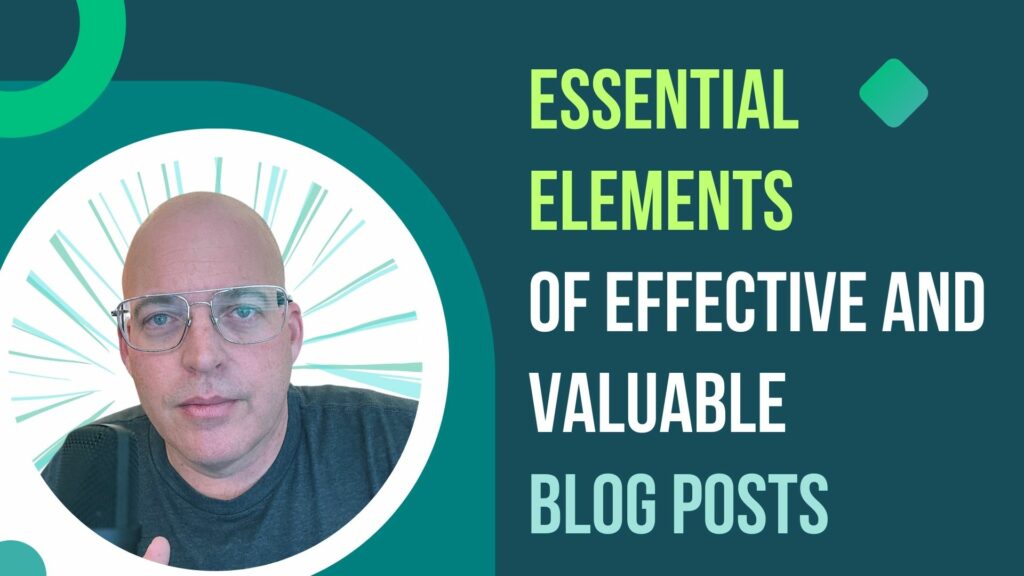Quality and valuable blog posts go beyond information dissemination, crafting a narrative that resonates with the reader, educates, and inspires action. Well-crafted posts stand out in a saturated digital landscape, fostering trust and authority in a brand. This pursuit of excellence in blogging is not just beneficial—it’s imperative for any business seeking to engage and expand its audience effectively.
As the digital ecosystem evolves, so does the definition of high-quality content. The pillars that uphold valuable blog posts are dynamic yet distinct. In the forthcoming discussion, we’ll explore the seven cardinal elements that can transform a simple post into compelling content that captivates and converts. These components serve as the foundation for meeting and exceeding the expectations of a discerning readership.
Business Objectives and User Intent Alignment
When aligning content with business goals and user intent, the aim is to create a strategic synergy that drives targeted traffic while supporting business aspirations. This dual-focused approach ensures that content bridges the user’s needs and the company’s offerings.
Delving into the specifics of user intent requires a keen analysis of audience behaviour and search patterns. By doing so, content creators can shape blog posts that draw in readers and guide them through the marketing funnel with precision and intent.
In essence, the alignment is a strategic exercise that turns a business blog into a consumer interest and company narrative nexus, fostering a relationship where both parties find value in the exchange.

In-depth coverage of Specific Topics
Diving deeply into specific topics on a blog showcases a commitment to thoroughness and expertise. It signals to readers that the blog is more than just a surface-level resource—it’s a hub for in-depth understanding that respects the complexities of its niche. Such comprehensive treatment of subjects educates and builds the brand’s credibility behind the content.
Executing this requires meticulous research involving more than just a cursory glance at related materials. It means engaging with the latest studies, sourcing original insights from industry experts, and dissecting complex ideas into digestible yet substantial content. This rigorous approach to content creation caters to both novice readers and seasoned professionals alike.
A blog consistently delivering detailed explorations on targeted subjects becomes a beacon in its field, attracting a dedicated following. Readers return not just for information but for the nuanced understanding and the value that such detailed content provides. This turns casual visitors into loyal readers and, potentially, into customers who trust the brand’s expertise.
Problem Solving and Providing Actionable Advice
Content that hones in on the reader’s problems serves as a beacon, guiding them through challenges with practical solutions. This type of content increases relevance and positions the blog as a go-to resource, building a relationship anchored in utility and trust.
Crafting posts that offer actionable advice requires a deep understanding of the reader’s journey. It outlines achievable and clearly explained steps, allowing readers to apply the advice confidently. A blog that succeeds in this becomes more than a source of information—it transforms into a partner in the reader’s personal or professional growth.
Ultimately, problem-solving content is about empowering the reader. It’s about delivering a sense of achievement that comes with tackling issues head-on, armed with advice tailored to real-world applications. This empowerment turns occasional readers into dedicated followers keen on the blog’s insights.

Incorporating Real-World Examples and Data
Incorporating real-world examples and data into blog content anchors abstract concepts to tangible outcomes, greatly enhancing the reader’s understanding and trust. Case studies and relevant statistics validate the points made, allowing the blog to stand as an evidence-based authority. This technique not only bolsters the credibility of the content but also makes it more relatable and convincing to the audience.
Finding credible examples and data involves diligent research and sourcing from reputable institutions or industry studies. When integrating these into blog posts, it is crucial to ensure they directly reinforce the content’s message. Data should be current and accurately represented, while case studies should be relevant and detailed, providing a clear narrative that effectively illustrates the blog’s key points.
The impact of well-integrated examples and data can be profound, transforming content from informative to insightful. It allows readers to see the practical application of information, giving the content a persuasive edge. By carefully selecting and presenting real-world evidence, a blog can significantly elevate its authority and the value it offers to its readers.
Use of Custom Visuals
Custom visuals are critical in enhancing comprehension as a visual shorthand for complex ideas. Unique graphics and images can break down barriers to understanding by illustrating concepts that words alone might not fully convey. They engage in different learning styles, making content more accessible and memorable.
One can employ various tools to create custom visuals, from user-friendly design platforms like Canva to more sophisticated software like Adobe Illustrator. The strategy lies in developing visuals that complement the textual content, using brand-consistent colors and styles that make the blog visually appealing while reinforcing its message.
Employing custom visuals is not just about aesthetics; it’s a strategic move towards clarity and engagement. Tailoring imagery to the content draws the eye and underscores and enhances key points, making the reader’s journey through the article informative and visually stimulating.

Sharing Relevant Resources and Tools
Incorporating links to additional resources and tools is a strategy that enriches blog content, serving as a testament to the thoroughness of research and the intent to provide comprehensive knowledge. This approach enhances the reader’s journey by offering them gateways to delve deeper into the subject matter, reinforcing the blog’s commitment to delivering value.
Selecting relevant resources demands a careful vetting process to ensure that the materials are not only pertinent but also from reliable sources. Prioritizing user-friendliness is also key; resources should be presented organized, with clear annotations on how they contribute to the topic at hand, thus fostering a seamless learning experience.
Sharing these resources is a practice that positions a blog as a knowledge hub. Readers can gain initial insights and embark on a more detailed exploration of this place. It’s a practice that reflects on the blog’s credibility and enhances the overall value proposition to the reader, making it a resource that readers return to and recommend.
Scannability and Conversational Tone
Crafting scannable content ensures that readers can quickly find the information they need, making the article more accessible and increasing the likelihood of the content being read and shared. A conversational tone, on the other hand, makes the information relatable and engaging, as if the writer is having a direct dialogue with the reader. This combination is essential in a digital landscape where attention spans are limited and personal connection is valued.
Tips for achieving this include using headings and subheadings to organize content and highlighting important phrases in bold to draw attention. The aim is to make the content easy to skim.
Writing in a conversational tone involves using an active voice to create a feeling of a one-on-one conversation. This approach helps to demystify complex topics, making the reader feel included in the discussion. It’s about transforming the reading experience into an interactive session where the reader feels heard and engaged.
Crafting Content That Counts
In conclusion, the essence of compelling blog content lies in its ability to align with business and user objectives. When enhanced by custom visuals and augmented with valuable resources, such content informs and captivates. By adopting these strategies, content creators can forge articles that resonate deeply with their audience.

Frequently Asked Questions
How Frequently Should I Update My Blog with New Content?
Consistency is key in blogging. Aim to post regularly, whether daily, weekly, or bi-weekly, to keep your audience engaged and signal to search engines that the site is updated regularly.
Can I Repurpose Old Blog Content?
Absolutely. Updating old posts with new information and visuals can bring renewed interest to topics that contribute to SEO efforts.
Should I Focus on Length or Quality When Creating Blog Posts?
Quality should always be your priority. While longer posts often rank better in search engines, the content’s value and relevance will keep readers returning.
How Can I Measure the Effectiveness of My Blog Content?
Utilize analytics to track metrics like page views, time on page, bounce rate, and social shares. These insights can help determine what content resonates with your audience and inform future posts.








